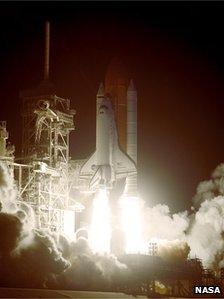Liquid-living worms survive space
- Published

About 4,000 worms boarded space shuttle Discovery
Worms have survived their first space mission - living in liquid.
The result, , means worm colonies can be established on space stations without the need for researchers to tend to them.
The animals are helping scientists understand the effects of weightlessness and high radiation levels experienced in space.
Lessons learned could one day assist humans to explore the Solar System.
In 2001, Stephen Hawking is to have said: "I don't think the human race will survive the next 1,000 years, unless we spread into space. There are too many accidents that can befall life on a single planet. But I'm an optimist. We will reach out to the stars."
But space is no easy amble. Humans must first learn to cheaply and safely propel themselves into space regularly, and then, once there, must adapt to high levels of radiation and to weightlessness.
In preparation for longer spaceflight, scientists have , and continue to study the ill-effect of weightlessness on astronauts.
The gravity studies have mostly focused on a group of muscles - broadly known as anti-gravity muscles - that seem to deteriorate without the gravitational pull of the Earth. However, there is some evidence for the weakening in all muscles, including the hearts of astronauts.
Weightlessness not only sees animals use their muscles less, but causes changes in the chemical reactions within the muscle cells, explained Nathaniel Szewczyk from the University of Nottingham, who is the lead author in the journal of the Royal Society Interface.
An automated multi-generational growth chamber will keep the worms healthy
Dr Szewczyk, and his team, looked at the effects of weightlessness on the muscles of the much-studied worm species Caenorhabditis elegans. These multicellular animals share many genes with humans, and can therefore help scientists gauge the long-term impacts of deep spaceflight on human life.
The recent mission saw Dr Szewczyk's worms return to Earth with the space shuttle Discovery after 6 months in orbit. It was the longest time worms have survived and been recovered, he said.
Liquid lunch
This was possible because the international team established an automated setup for growing worms that transferred a subset of the animals to fresh food every month, filming the worms' progress as they went.
The technique was dependent on establishing that worms fare just as well in liquid as they do on their usual agar plates.
He explains that "because we had the bad experience with shuttle STS-107, which of course is the shuttle that broke up, we are keen [to] avoid being dependent on getting the worms back."
This way, the researchers can gather data on the worms from space, and automating the worm culturing also means less work.
Dr Szewczyk, like all UK scientists, is currently dependent on collaborating with international space programmes to get their animals into space.
However, the UK is in the process of considering whether to join the European Programme for Life and Physical Science (Elips), a European Space Agency-run programme that would give British scientists more direct access to the space station. The decision will be taken next year.
Related topics
- Published31 October 2011
- Published17 November 2011